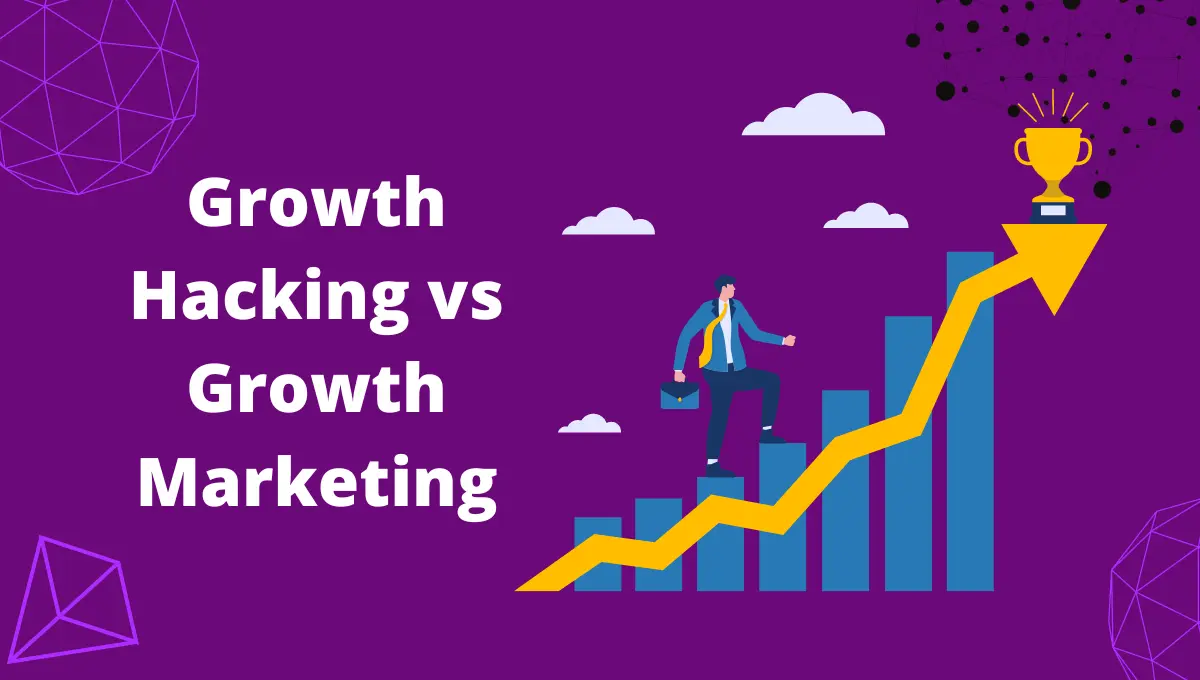“Growth hacking” and “growth marketing” are terms often used interchangeably by many. In fact I find it astonishing how people bandy about “growth hacker” or “growth marketer” in their LinkedIn headlines without any consideration for what exactly are these terms and how are they different from each other.
Growth hacking and growth marketing carry different connotations and focus areas. Both concepts are geared towards achieving business growth, but they employ distinct approaches and methodologies.
While growth hacking tends to focus on quick wins and rapid growth through creative and often aggressive tactics, growth marketing is about incorporating the insights gained from those tactics into a consistent, scalable and long term strategy. The tactics deployed for growth marketing are often the part of the brand’s essence and its key differentiating factor.
Growth hacking can be seen as a subset of growth marketing, utilized typically during the early stages of a product or business launch. Brands often outgrow growth hacking tactics and in the long run adopt any of those tactics as a long term business growth strategy. At that point a growth hacking strategy becomes a growth marketing strategy.
Tinder’s Swipe feature is a good example. It was a unique way to accept or reject profiles and was introduced as a growth hack to make the app more engaging and fun. But it has become so popular since then that it has become a defining feature of Tinder as a brand.
Both growth hacking and growth marketing are essential for businesses, and the choice between focusing on growth hacking or growth marketing often depends on the stage of the business, the business goals, and the available resources.
Let’s understand the differences between growth hacking and growth marketing.
Growth Hacking
Definition: Growth hacking is a technique developed by startups which uses creative, low-cost strategies to help businesses acquire and retain customers. Essentially, it involves experimenting across product and marketing channels to identify the most effective, efficient ways to grow a business.
Focus: It is heavily focused on rapid experimentation across marketing funnels, product development, sales segments, and other areas to identify the most efficient ways to grow a business.
Scope: Typically limited in scope to specific campaigns or initiatives aimed at increasing a company’s customer base or market share quickly and with minimal expenditure.
Process: Growth hacking focuses heavily on experimentation and iteration. Different growth features are developed, tested, and refined over time.
Tools & Techniques: Growth hacking techniques can be broadly categorized into three buckets – product led growth hacking, where you develop features in your product that lead to viral adoption; engineering led growth hacking, where you develop additional free plugins, tools, that create a massive customer acquisition funnel for you; and marketing led growth hacking where you leverage marketing channels that give you extra ordinary returns.
Endpoint: The end goal is rapid growth, often disregarding the traditional pathways or longer-term branding strategies.
Growth Marketing
Definition: Growth marketing extends traditional marketing by adding layers of experimentation and performance metrics to more traditional marketing tactics. It seeks to optimize and find innovative ways across the entire customer lifecycle, from awareness through retention and referrals.
Focus: It looks at creating sustainable growth through data-driven marketing techniques and focuses on engaging users by creating value through every touch point with a brand.
Scope: Broader than growth hacking, as it includes building brand loyalty and delivering long-term value to ensure not just acquisition but also customer retention and brand loyalty.
Process: Growth marketing is algorithmic in the sense that is all about identifying winning patterns and optimizing those that work.
Tools & Techniques: Growth marketing involves utilizing various strategies such as product engagement features, SEO, content marketing, influencer marketing, A/B testing, email marketing automation, data analytics, and user journey optimization.
Endpoint: The emphasis is on building a sustainable brand alongside growth. It is as much about retaining and engaging existing users as gaining new ones.
Let’s understand the difference between growth hacking and growth marketing with a few examples of very well-known success stories.
Examples of Growth Hacking
Dropbox Referral Program
Strategy: Dropbox used a simple yet powerful referral program that leveraged its existing user base to drive growth. They incentivized users by offering extra storage space for both the referrer and the referee.
Result: This directly encouraged users to share Dropbox with their friends and family, significantly boosting user growth without traditional advertising spend.
Hotmail’s Email Signature
Strategy: At the end of every email sent from a Hotmail account, the company added a signature that said, “PS: I love you. Get your free Email at Hotmail.” This simple hack turned every email sent by a Hotmail user into a potential Hotmail ad.
Result: It contributed substantially to Hotmail’s viral growth, reaching millions of users rapidly.
Airbnb’s Craigslist Integration
Strategy: In its early days, Airbnb offered a platform for users to post their rental listings to Craigslist automatically, albeit using an unofficial method. This exposed Airbnb’s listings to a much larger audience who were already looking for accommodation solutions.
Result: This significantly boosted Airbnb’s user base and helped establish it as a go-to platform for short-term rentals.
Instagram’s Seamless Social Sharing
Strategy: When Instagram first launched, it allowed users to seamlessly share their Instagram posts on other social media platforms like Facebook, Twitter, and Tumblr. This strategy leveraged the existing user bases of these larger platforms.
Result: This created a viral loop that boosted Instagram’s visibility and user growth. Each shared photo acted as a natural advertisement for Instagram, attracting new users who wanted to engage with this new, visually-centered social platform.
PayPal’s Signup and Referral Bonuses
Strategy: In its early days, PayPal offered new users a cash incentive (initially $10, later reduced) for signing up and an additional cash bonus for referring friends.
Result: This direct financial incentive motivated users to join and share PayPal with others, resulting in exponential growth that helped establish PayPal as a leader in online payment solutions.
LinkedIn’s “People You May Know” Feature
Strategy: LinkedIn introduced the “People You May Know” feature, which uses algorithmic recommendations to suggest potential connections. This made it easier for users to find colleagues and encouraged more connections and interactivity on the platform.
Result: This feature significantly increased user engagement and network growth, as users were more likely to join and stay active on the platform if they could easily connect with others.
Tinder’s Swipe Feature
Strategy: Tinder revolutionized the online dating scene with its simple and addictive swipe feature, which gamified the process of finding a match. Users swipe right to like another user and left to pass, enabling quick and intuitive browsing of potential matches.
Result: This distinctive feature helped differentiate Tinder from other dating apps, making it easy and fun to use, which contributed to its rapid user growth.
Uber’s Surge Pricing Algorithm
Strategy: Uber uses a dynamic pricing model called “surge pricing” which increases prices during high-demand periods. This not only manages supply and demand but also incentivizes more drivers to get on the road during these times.
Result: Surge pricing helped Uber maximize availability and reliability, attributes that greatly contributed to its rapid growth in multiple cities worldwide.
Twitter’s Suggested Follows and Hashtags
Strategy: Twitter encourages new users to follow other popular accounts and interact with trending hashtags. This immediate engagement upon sign-up helps new users find interesting content and become active participants quickly.
Result: This approach helps to keep the platform dynamic and engaging, boosting user growth and retention by quickly integrating new users into the community.
Examples of Growth marketing
HubSpot’s Inbound Marketing
Strategy: HubSpot is a pioneer in inbound marketing, offering an array of tools including content management, social media scheduling, email marketing, SEO, and more. They focus heavily on providing valuable content through their blogs, free tools, and courses, drawing users into their ecosystem.
Result: This approach has helped establish HubSpot as a thought leader in the marketing industry, fostering strong customer loyalty and consistent growth in subscriptions.
L’Oréal’s Beauty Squad Influencer Campaign
Strategy: L’Oréal UK leveraged influencers to reach broader demographics. They built a community called the “Beauty Squad,” made up of influential beauty bloggers and vloggers. The influencers created content and shared their experiences using L’Oréal products across their personal channels.
Result: This strategy helped L’Oréal engage with younger audiences in a more personalized and trustworthy manner, boosting product awareness and sales.
Netflix’s Use of Big Data
Strategy: Netflix uses big data analytics to understand viewer preferences, helping to inform their content creation and acquisition strategies. They track various metrics to predict what users might want to watch next and customize content recommendations accordingly.
Result: By continually optimizing user experiences and ensuring high content relevancy, Netflix maintains high engagement rates, minimizes churn, and steadily increases its user base globally.
Amazon Prime
Strategy: Amazon developed Prime, a subscription service offering free shipping, exclusive access to movies, TV shows, ad-free music, Kindle books, and more. Prime is designed to increase customer loyalty and the frequency of purchases.
Result: Prime members tend to spend more and shop more frequently than non-Prime members, significantly boosting Amazon’s revenue and reinforcing its market dominance.
American Express Open Forum
Strategy: American Express created the Open Forum platform for business owners to share knowledge and insights. It provides valuable content like articles and videos on topics ranging from leadership to marketing, produced by industry experts and thought leaders.
Result: This initiative has helped American Express build a community around its brand, fostering deeper customer engagement and positioning itself as an essential partner for business owners.
Adobe’s Shift to Subscription-Based Model
Strategy: Adobe transitioned from a traditional, perpetual license model for its software suite to a subscription-based model with Adobe Creative Cloud. This model provides continuous updates, cloud storage, and easier access to a suite of products for a monthly fee.
Result: The subscription model has allowed Adobe to provide better and more frequent updates, improve customer satisfaction, and significantly increase their recurring revenue.
Canva’s Freemium Model and Utility Content
Strategy: Canva offers a freemium model where users can access many design tools for free, with the option to buy premium features. They also provide extensive learning resources and templates to help users create better designs.
Result: This dual approach of offering free valuable tools along with paid upgrades encourages user adoption and retention, while their extensive resources help users achieve better results, thereby promoting user dependency and loyalty.
Spotify’s Personalized Playlists
Strategy: Spotify uses sophisticated algorithms to create personalized playlists like “Discover Weekly,” which is updated every Monday with new songs tailored to each user’s music preferences. This personalization extends to podcasts and other content recommendations.
Result: Such features increase user engagement and time spent on the platform. They also enhance user satisfaction by consistently delivering new, personally appealing content, thus retaining users and encouraging subscriptions.
Duolingo’s Streak Feature
Strategy: Duolingo, the language learning app, incorporates game-like elements such as a “streak” feature, which counts the number of consecutive days a user has completed a lesson. Users are encouraged to maintain their streak, and they receive in-app reminders and incentives to keep their learning habit going.
Result: This feature significantly increases daily user engagement and helps in forming a habit. Maintaining a streak also encourages longer subscription periods and word-of-mouth referrals due to its community aspect.
About The Author
Get A Free Consultation
I can help you grow your HR services business.
Recruitment & Staffing, employee background screening, employee engagement and training, HR outsourcing, HR consulting, statutory and labour compliance, payroll outsourcing, employee benefits and insurance services, employee healthcare services – if your business belong to any of these categories, I can help you grow your business. Just submit this form with your details and I will provide a complete growth blueprint for you.


